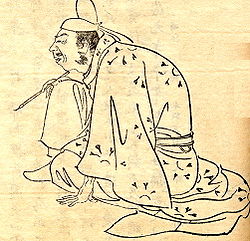- Ono no Michikaze
-
Ono no Michikaze or Ono no Tōfū (小野 道風, 894 – February 9, 966) was a prominent Shodōka (Japanese calligrapher) who lived in the Heian period (794–1185). One of the so-called Sanseki 三跡 (Three Brush Traces), along with Fujiwara no Sukemasa and Fujiwara no Yukinari. Tōfū is considered the founder of Japanese style calligraphy or wayōshodō 和様書道.
Contents
Life
Michikaze was born in the present Kasugai, Aichi prefecture, as the grandson of a courtier-poet, Ono no Takamura. He was a government official, a poet and a calligrapher. He provided highly distinguished calligraphic services for three emperors during his career: Daigo (reigned from 897 to 930), Suzaku (reigned from 930 to 946) and Murakami (reigned from 946 to 967). Michikaze's fame permitted him to serve, at the age of twenty-seven, in the Seiryoden, the residential quarters of the imperial court.
As a recognition of his high skill, Emperor Daigo offered the Buddhist monk Kanken two volumes of Michikaze's works in 927, and urged him to take them with him on a voyage to China, and commend Michikaze’s calligraphic achievements to the Chinese.
Michikaze had lost much of his sight by the time he died.
Works
Michikaze took the first step in Japanizing the art of calligraphy, imported from China around the 5th century. His works were slightly influenced by the style of the legendary 4th-century Chinese calligrapher Wang Xizhi, however, he added his own refinments, that resulted in a softer feel with more freedom of movement than was common under the strictures of Chinese calligraphy.
He created the Japanese style calligraphy (wayo) that was later refined by other two masters, Fujiwara no Sukemasa and Fujiwara no Yukinari. Wayo was accredited and practiced, as a pure Japanese art form, until the mid-19th century.
Michikaze showed great diligence in his works, which resulted in grandiose character forms, and powerful lines. None of Michikaze's kana calligraphy are extant. A number of extant kanji works are believed to be by Michikaze, but only a few are positively attributed. One of the well-known works ascribed without much evidence to Michikaze is a draft for an inscription on a byoubu (Japanese folding screen) now mounted as a handscroll in the Tokyo Imperial Household collection. It was executed in semi-cursive script (gyosho), and consisted of ten poems by Michikaze's contemporary Oe no Asatsuna. The collection also has his other masterpieces, like the Gyokusen-Jo handscroll, which are poems by a Tang poet. Michikaze also was attributed to many kohitsu-gire (famous calligraphic works) of the Heian era, among which a scroll containing forty-nine waka poems from the twelfth volume - "Poems of Love" - of the early-Heian poetry anthology, Kokin Wakashū. Among his last works are eleven letters, in one of which he bemoans the evanescence of life.
Legacy
- On the 20th October 2000 (Heisei 12), an 80¥ "Willow and frog" stamp was issued in Aichi Prefecture, depicting Michikaze watching a leaping frog and a frog.
- There is a shrine to his spirit in Kyoto, where his divine soul is considered to be protecting the women of the region in maternity.
- Ono no Michikaze is depicted on the "rainman" of the traditional Japanese playing cards Hanafuda.
See also
References
Categories:- 894 births
- 966 deaths
- Japanese calligraphers
Wikimedia Foundation. 2010.



